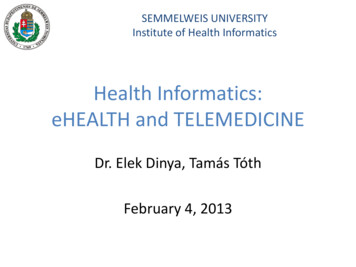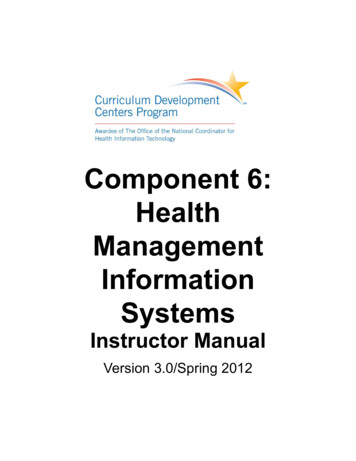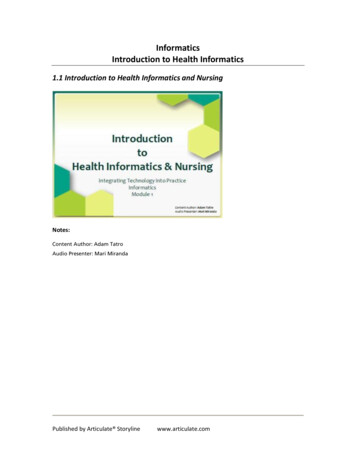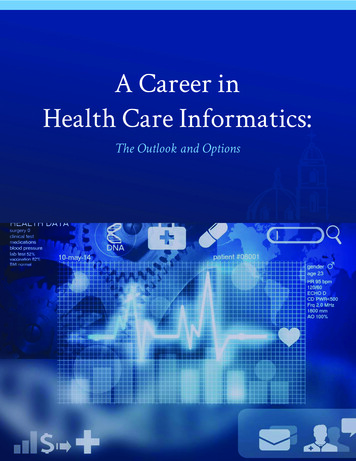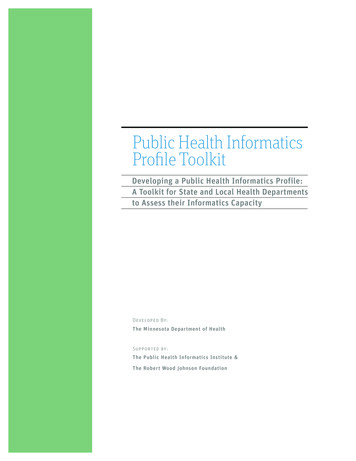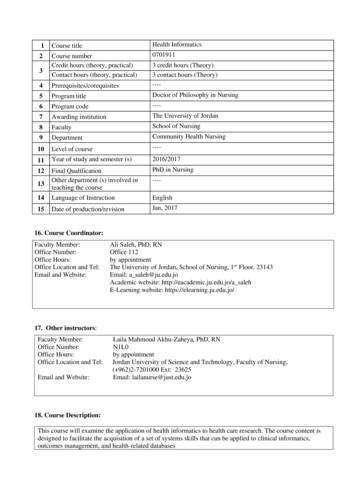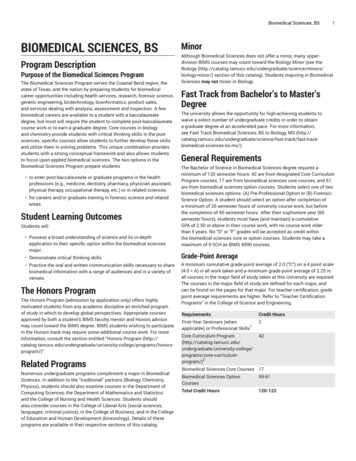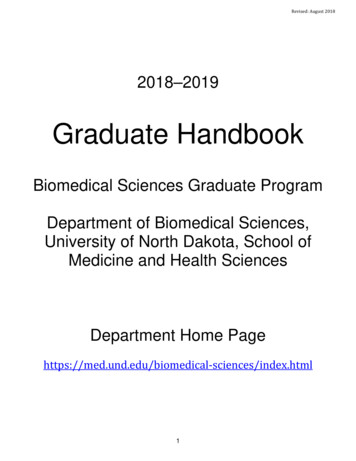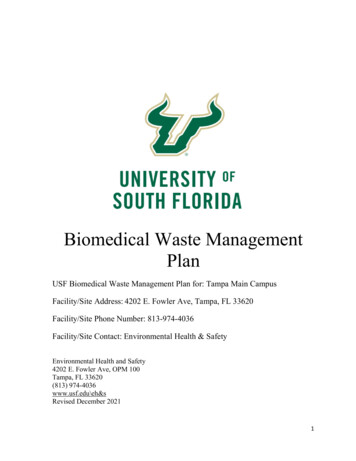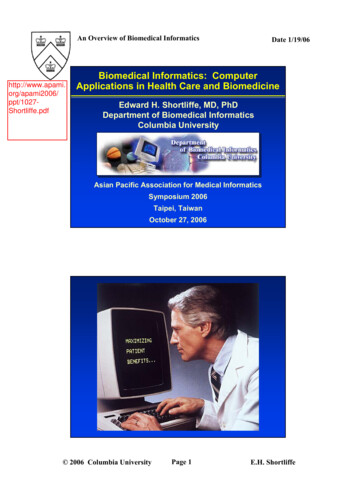
Transcription
An Overview of Biomedical Shortliffe.pdfDate 1/19/06Biomedical Informatics: ComputerApplications in Health Care and BiomedicineEdward H. Shortliffe, MD, PhDDepartment of Biomedical InformaticsColumbia UniversityAsian Pacific Association for Medical InformaticsSymposium 2006Taipei, TaiwanOctober 27, 2006 2006 Columbia UniversityPage 1E.H. Shortliffe
An Overview of Biomedical Informatics 2006 Columbia UniversityPage 2Date 1/19/06E.H. Shortliffe
An Overview of Biomedical InformaticsDate 1/19/06Today’s TopicAcademic Biomedical Informatics Definitions and scope Terminology Textbook of Biomedical Informatics Education of Biomedical Informatics professionals Education of Biomedical Informatics researchers– Scientific papers– Doctoral dissertations Education of health professionals about informatics Creation of new academic units– Graduate training and recruitment of faculty Anticipating the futureWhat is Biomedical Informatics? Is it a “real” academic discipline?– Scientific base?– Here to stay? Is it needed both in universities and inthe world beyond?– Job opportunities?– Are people filling those roles now?– Are there enough of them? How does it relate to other disciplines?– Duplicative?– Interdisciplinary? 2006 Columbia UniversityPage 3E.H. Shortliffe
An Overview of Biomedical InformaticsDate 1/19/06Historical Perspective Computers in medicine emerged as a youngdiscipline in the 1960s– Most applications dealt with clinical issues No consistency in naming the field for many years– “Computer applications in medicine”– “Medical information sciences”– “Medical computer science” Emergence in the 1980s of a single, consistentname, derived from the European (French) termfor computer science: informatique– Medical InformaticsThe Last 25 Years US Govt-supported medical informaticstraining programs at several universities(now 18 programs)– Application areas broadened in recent years toinclude biological sciences, imaging, and otherbiomedical domains Creation of professional societies, degreeprograms, quality scientific meetings,journals, and other indicators of a maturingscientific discipline Broadening of applications base, but with agrowing tension between the field’s servicerole and its fundamental research goals 2006 Columbia UniversityPage 4E.H. Shortliffe
An Overview of Biomedical InformaticsDate 1/19/06Issues For Academic Informatics Conveying the fundamental issues in the fieldto colleagues who equate “true science” withlife-science discoveries, typically in the wetbench laboratory Finding the right mix between research/trainingand service requirements Dealing with the challenges of aninterdisciplinary field that demands peerrelationships with individuals in the computerscience and biomedical fields as well as inbiomedical informatics itselfBiomedicalWhat’s inInformaticsa Name?BiomedicalMedical informatics is the scientific fieldthat deals with the storage, retrieval,sharing, and optimal use of biomedicalinformation, data, and knowledge forproblem solving and decision making.BiomedicalMedical informatics touches on all basicand applied fields in biomedical scienceand is closely tied to modern informationtechnologies, notably in the areas ofcomputing and communication. 2006 Columbia UniversityPage 5E.H. Shortliffe
An Overview of Biomedical InformaticsDate 1/19/06Relationship of MedicalInformatics and BioinformaticsBiological andClinicalApplications ofInterrelatedBioinformatics Techniques andMethodsMedicalInformaticsAnticipation oftheir FutureClinicalInterdependenciesBiomedical Informatics in PerspectiveBasic ResearchBiomedical Informatics Methods,Techniques, and TheoriesBioinformaticsApplied Research 2006 Columbia UniversityImagingInformaticsPage 6ClinicalInformaticsPublic HealthInformaticsE.H. Shortliffe
An Overview of Biomedical InformaticsDate 1/19/06Biomedical Informatics in PerspectiveBasic ResearchApplied ResearchBiomedical Informatics Methods,Techniques, and TheoriesBioinformaticsMolecular andCellularProcessesImagingClinicalInformatics InformaticsTissues andOrgansIndividuals(Patients)Public HealthInformaticsPopulationsAnd SocietyBiomedical Informatics in PerspectiveContribute to.Biomedical Informatics Methods,Techniques, and raw upon .Contributes to .ClinicalPracticeClinicalInformaticsDraws upon . 2006 Columbia UniversityPage 7E.H. Shortliffe
An Overview of Biomedical InformaticsDate 1/19/06Biomedical Informatics in PerspectiveContribute e,InformationSciences,ManagementSciencesand otherComponentSciencesBiomedical Informatics Methods,Techniques, and TheoriesDraw upon .Contributes to .BioinformaticsDraws upon ical Informatics e(hardware)Cognitive Science& Decision ogyAnd StatisticsManagementSciencesClinicalSciences 2006 Columbia UniversityBasic BiomedicalSciencesPage 8E.H. Shortliffe
An Overview of Biomedical InformaticsDate 1/19/06Biomedical Informatics in PerspectiveBiomedical Informatics Methods,Techniques, and TheoriesBasic ResearchApplied ResearchBioinformaticsMolecular andCellularProcessesImagingClinicalInformatics InformaticsTissues ath MiningModelingPublic HealthInformaticsPopulationsAnd SocietyEducation of BiomedicalInformatics ProfessionalsBasic ResearchBiomedical Informatics Methods,Techniques, and TheoriesEducationandExperienceat BothLevelsBioinformaticsApplied Research 2006 Columbia UniversityImagingInformaticsPage 9ClinicalInformaticsPublic HealthInformaticsE.H. Shortliffe
An Overview of Biomedical InformaticsDate )Springer Verlag - 2000 2006 Columbia UniversityPage 10E.H. Shortliffe
An Overview of Biomedical InformaticsDate ringer - 2006Unit I: Recurrent Themes inBiomedical Informatics1.The Computer Meets Medicine and Biology:Emergence of a Discipline2.Biomedical Data: Their Acquisition, Storage, and Use3.Biomedical Decision Making: Probabilistic Reasoning4.Cognitive Science in Support of Biomedical Informatics5.Essential Concepts for Biomedical Computing6.System Design and Engineering7.Standards in Biomedical Informatics8.Natural Language and Text Processing in Biomedicine9.Imaging Informatics10. Ethics and Health Informatics:Users, Standards, and Outcomes11. Evaluation and Technology Assessment 2006 Columbia UniversityPage 11E.H. Shortliffe
An Overview of Biomedical InformaticsDate 1/19/06Biomedical InformaticsBiomedical Informatics Methods,Techniques, and TheoriesBasic ResearchUnit I informaticsApplied ResearchClinicalInformaticsPublic HealthInformaticsUnit II: Biomedical InformaticsApplications12. Electronic Health Record Systems13. Management of Information in HealthcareOrganizations14. Consumer Health Informatics and Telehealth15. Public Health Informatics and the Health InformationInfrastructure16. Patient-Care Systems17. Patient Monitoring Systems18. Radiology Systems19. Information Retrieval and Digital Libraries20. Clinical Decision-Support Systems21. Computers in Health Science Education22. Bioinformatics 2006 Columbia UniversityPage 12E.H. Shortliffe
An Overview of Biomedical InformaticsDate 1/19/06Biomedical InformaticsBasic ResearchBiomedical Informatics Methods,Techniques, and TheoriesUnit II of“BiomedicalInformatics”BioinformaticsApplied c HealthInformaticsUnit III: Biomedical Informaticsin the Years Ahead23. Healthcare Financing and Information Technology:A Historical Perspective24. The Future of Computer Applications in BiomedicineGlossaryReferencesName IndexSubject Index 2006 Columbia UniversityPage 13E.H. Shortliffe
An Overview of Biomedical InformaticsDate 1/19/06Education of BiomedicalInformatics ResearchersBasic ResearchBiomedical Informatics Methods,Techniques, and TheoriesEducationandExperienceat ed c HealthInformaticsFundamental Research in Informatics Although projects are inspired by biomedicalapplication goals, basic research in biomedicalinformatics typically:–offers methodological innovation, not simplyinteresting programming artifacts–generalizes to other domains, within oroutside biomedicine Inherently interdisciplinary, biomedicalinformatics provides bridging expertise andopportunities for collaboration betweencomputer scientists and biomedicalresearchers and practitioners 2006 Columbia UniversityPage 14E.H. Shortliffe
An Overview of Biomedical InformaticsDate 1/19/06Biomedical Informatics Basic ResearchBasic ResearchBiomedical Informatics Methods,Techniques, and TheoriesContributionsExpectedBioinformaticsApplied c HealthInformaticsMessages to Students Individual projects will always be applications-motivated Solutions often require informatics innovation rather than“off-the-shelf” software or tools Researchers must ask what general lessons can be derivedfrom the work that they do– Of what class of applications is the project an example?– What is the range of applicability of the methodsdeveloped?– How can the work be described generically,independently of the application that motivated it There is a role for applications papers and evaluations, butthe science of informatics requires that we identify anddescribe the generalizability and reusable lessons of apiece of work 2006 Columbia UniversityPage 15E.H. Shortliffe
An Overview of Biomedical InformaticsDate 1/19/06Biomedical Informatics ResearchBiomedical Informatics Methods,Techniques, and TheoriesBasic ResearchJournal ofBiomedicalInformaticsBioinformaticsApplied c HealthInformaticsDoctoral DissertationsChapter 1:Introduction and OverviewChapter 2:Literature ReviewChapter 3:Overview of Methodological InnovationChapter 4:System Component #1.Chapter 4 K: System Component #KChapter N-2: Examples of Total System’s OperationChapter N-1: Formal Evaluation of Method in the Context ofthe ApplicationChapter N:Summary of Contributions and Future WorkTypically N 8 or 9 2006 Columbia UniversityPage 16E.H. Shortliffe
An Overview of Biomedical InformaticsDate 1/19/06Education of HealthProfessionalsBasic ResearchBiomedical Informatics Methods,Techniques, and TheoriesLimitedExposure toMethodsEducationandExperienceat AppliedLevelBioinformaticsApplied c HealthInformaticsIssues in Teaching Medical StudentsAbout Biomedical Informatics Columbia experience starting inAutumn 2005 How to make the topic seem relevant? Learning climate: students need towant to learn about the topic Lack of role models in clinical trainingsettings Curriculum design: How to integrateinformatics topics throughout training? Emphasize teaching by physicians whoare cross-trained in informatics 2006 Columbia UniversityPage 17E.H. Shortliffe
An Overview of Biomedical InformaticsDate 1/19/06Student Reactions Mixed and bimodal Extreme example of negative:“I still don’t think informatics is relevant tomy becoming a surgeon. I will have nothingto do with any of the stuff taught. I don’t wantto. I am 100% against computerizedmedicine, and I don’t want doctors to turn intorobots. I don’t want to use a computer tomake decisions. And nobody should. If youneed a computer to become a competentdoctor, then you shouldn’t become onebecause you’re not cut out for it.”Student Reactions Example of positive:“Content of presentations was strong.Demonstrated the relevance of informatics toeveryday clinical decisions. Thepresentations were definitely worthwhilepreparing for and listening to.” 2006 Columbia UniversityPage 18E.H. Shortliffe
An Overview of Biomedical InformaticsDate 1/19/06To-Do List for a New Program Attract faculty who understand biomedical informaticsas science, not just as means to reach pragmatic ends– Joint (secondary) appointments for faculty fromother units– Primary appointments only for informaticians Attract faculty committed to education as well asresearch, well-trained in informatics, and who embracethe notion that BMI spans applied disciplines across allof biomedicine Include graduate education as soon as possible, anddo not wait to include doctoral training as well asmasters Build diversified financial base: institutional,government, industrial, and foundationsTo-Do List for a New Program - 2 Link the department to transformation of modernknowledge dissemination in universities (i.e., to thelibrary of the future) Seek diversity across the areas of application so thattraining does not become too narrow, even thoughstudents may be specializing in one of the applicationareas Seek to build and maintain visibility within theinstitution:– Collaborations– Some (limited) service activities– Presentations that educate others about the fieldand its relevance to modern biomedicine 2006 Columbia UniversityPage 19E.H. Shortliffe
An Overview of Biomedical InformaticsDate 1/19/06Trends In The USA (and beyond?) Creation of several new biomedical informaticsdepartments or independent academic units Strong job market for graduates of informatics degreeprograms Government investment in training and research isreasonably strong, especially for applications anddemonstrations Increasing acceptance of biomedical informatics as asubspecialty area by biomedical professionalsocieties Increasing recognition that biomedical problems candrive the development of basic theory andcapabilities in information technology research 2006 Columbia UniversityPage 20E.H. Shortliffe
(3rd edition) Unit I: Recurrent Themes in Biomedical Informatics. 1. The Computer Meets Medicine and Biology: Emergence of a Discipline 2. Biomedical Data: Their Acquisition, Storage, and Use 3. Biomedical Decision Maki ng: Probabilistic Reasoning 4. Cognitive Science in Support of Biomedical Informatics 5. Essential Concepts for Biomedical .
